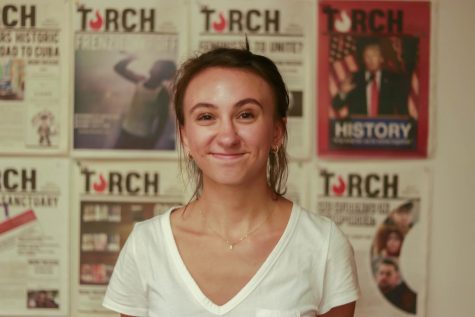On Thursday, March 28, Hasia R. Diner, Ph.D, a Paul S. and Sylvia Steinberg Professor of American Jewish History at New York University, Director of Goldenstein-Goren Center for American Jewish History and the Interim Director of Glucksman Ireland House at NYU, presented her lecture entitled “Twinned Histories: Irish and Jewish Immigrants to the United States” to more than 400 students in the Marillac Auditorium.
Dr. Diner currently teaches HIS 4993: “America: A Nation of Immigrants,” here on the St. John’s University Queens Campus and serves as the 2019 Peter P. and Margaret A. D’Angelo Chair in the Humanities – a rotating visiting professor position granted to experts in their respective field.
For her presentation, Dr. Diner spoke on the subject of Jewish and Irish immigration during the late 19th and early 20th century and how each redefined both America and each other.
According to Dr. Diner’s research, the Irish taught Jewish immigrants how to become American and Jewish immigrants turned to the Irish in crisis to “defend their case to a larger society” – a call they answered when Irish newspapers exposed the anti-Semitism of the late 19th century. As with any constituency, the Irish – who dominated politics, labor unions, public entertainment and municipal services during the era – cultivated the Jewish vote by attending religious and social events.
“Neither the Jews or the Irish purposely sought the other as ally or partner. Each remained fiercely committed to community and tradition, but figure out they each had something to offer the other,” Dr. Diner explained.
Jewish female laborers – who dominated the garment industry in New York during this era – learned the tools of unionization from the Irish women that preceded them. Furthermore, Irish women in the teaching profession taught Jewish immigrants how to assimilate to American culture.
For Dr. Diner, these interactions were significant.
“The Irish-Jewish meeting, with its moments of teaching and learning, differed from the encounters Jews had in America with other immigrant and ethnic populations … In this complicate encounter, both sides looked to each other across a set of otherwise powerful divides, seeing possibilities for mutual benefit,” she said.
In a comment to the Torch, she expanded on the importance of this sediment for the St. John’s community in particular.
“First, St. John’s is a community of both recent immigrants, the children of immigrants, and the descendants of immigrants. I hope that those who heard will understand that no ‘group’ makes it on their own, but rather in a multi-ethnic society as the United States is, people do best when they understand how their fates are intertwined,” Dr. Diner explained .
“Historians and contemporary writers tend to think in: “silos” –– this group and then that group –– but yet all are dependent on each other and benefit from reaching out across conventional lines.”
“Secondly, as a Catholic institution founded by the sons of Catholic immigrants for the sons (and daughters of Catholic immigrants), the University has a history which involved both their needs and aspirations and those of others,” Dr. Diner said.
“I just looked through the yearbooks of the St. John’s pharmacy school from the 1930s and just by looking at last names, probably one-half or so of the students were Jewish. As such Catholic institutions have a deep and rich history of not only serving their own adherents but of impacting the lives of so many others. This, it seems to me, is a history that St. John’s should know, and also, be proud of.”
































